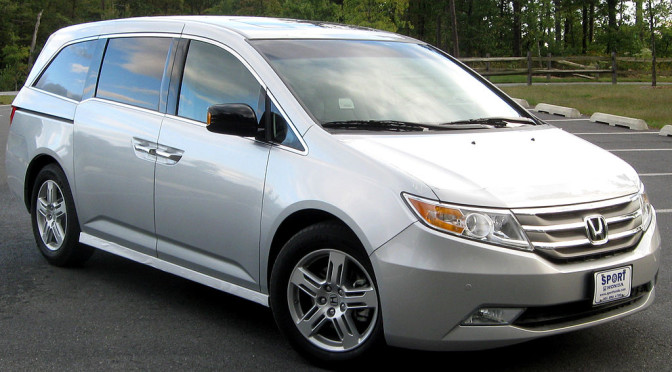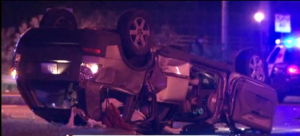 Rollovers are among the deadliest types of crashes we can be involved in as drivers or as passengers, despite being among the rarest types of crashes on the road. The facts from the NHTSA are sobering:
Rollovers are among the deadliest types of crashes we can be involved in as drivers or as passengers, despite being among the rarest types of crashes on the road. The facts from the NHTSA are sobering:
Per FMVSS 216, more than 10,000 deaths a year, or more than 1/3rd of all passenger vehicle fatalities in the US, involve rollover crashes. Of those fatalities, 47 percent of occupants killed are completely ejected from their vehicles, while another 10 percent are partially ejected. It’s worth noting that per the IIHS, only 2 percent of all vehicle crashes involve rollovers, despite their taking 1/3rd of all occupant lives.
While rollovers can last between one and several seconds, a vehicle can complete between 1/4 and 8+ turns (4/4 being a complete 360 degree revolution) in that time span. These crashes also tend to occur at faster speeds than other crashes since so much energy is required to initiate a rollover. Furthermore, while they can occur in multiple vehicle collisions, by far and large, they’re a single vehicle problem. Three out of every 4 rollover fatalities involve a single vehicle, and more than half of all single vehicle fatalities involve rollovers.
As a result, it’s worth looking into what we can do to reduce our risks of involvement in such crashes. This is part of an ongoing series on the safest vehicles I’m aware of in a range of categories. I recently wrote article on the safest 2015-model year vehicles for side impact crash protection, highlighting the leading cars, small cars, minivans, and SUVs and crossovers.
In the most recent post on small cars, I promised to look into the leading vehicles for surviving rollovers. It took a few months, but I’ve finally been able to define a metric, look at a number of crashes, and crunch some numbers. Let’s take a look at how to survive a rollover, and which factors make this more or less likely in the minivans available today in the United States.
What are the most important safety features a minivan can have for rollover protection and rollover resistance?
There are three features I’d consider essential in any vehicle, but especially in minivans, which are more top-heavy than cars, to adequately protect occupants during a rollover: electronic stability control, rollover-sensing side airbags, and a strong roof structure. Let’s look at each of these three points and then see where the current crop of US minivans stacks.
1. Electronic stability control. Electronic stability control, or ESC, is, in my books, one of the three most important inventions for car safety in the last sixty years, along with the 3-point seat belt and the air bag. Built as an extension of anti-lock brakes (ABS), ESC is designed to reduce the risks of oversteering, understeering, and rollovers by selectively and automatically braking front and rear wheels to maintain the balance and direction of travel of the vehicle.
To put it simply, it cuts your odds of rolling over to begin with by braking in order to keep your vehicle stable. It’s been estimated to cut the risks of a single vehicle fatal crash by 50%. Considering the fact that half of all fatal crashes are single vehicle crashes, this is a big, big deal. The NHTSA has directly stated that they estimate that ESC will reduce the 10,000+ US annual deaths attributed to rollovers to 5,000.
2. Rollover-sensing side airbags with head/torso protection. Most drivers by now understand the need to wear seat belts 100% of the time while driving, but airbags are also an extremely important component of rollover prevention. When your vehicle enters a rollover, you lose complete control of your body. You don’t get to hold on, brace yourself, or do anything else to stop the process. If the vehicle rolls right, your body will try to fly to the left, and directly out the window. If the vehicle rolls left, your body will try to fly to the right and directly out that window. The only way to stop this is to be braced within the vehicle through your seat belt, and that’s not always enough.This is where side airbags with head protection come in.
In some crashes, they make enough of a difference when deploying during rollovers to keep you in the vehicle, or to keep you from fracturing your skull against the window, roof rail, A pillar, or B pillar. They might simply keep your head in the vehicle and away from the ground that would crush it immediately during the rollover. But without such airbags, your odds of survival drop considerably.
Similarly, if you’re in a vehicle that features side airbags but not the kind programmed to deploy during rollovers, it’s like not having them to begin with in a rollover collision, because they won’t deploy unless the rollover is triggered by your being t-boned on the near-side by another vehicle–which makes the crash even more severe.
3. Strong roof. Finally, strong roofs are essential because if your vehicle doesn’t preserve the occupant cabin (which is now your survival space) sufficiently, nothing else matters, as you’re going to be crushed by the weight of your vehicle when it causes your roof to cave in. Or if you aren’t crushed by the caving-in-roof, your seat belt will detach and send you into the roof or out the vehicle. Your airbags will be useless because they either won’t deploy or won’t be there when you need them since the roof rail they deployed from now resembles a pretzel.
To put it simply, without a strong roof, you’re not going to see the end of a rollover, because your life will be over in an instant. But what makes a strong roof?
What makes a strong roof, and what should I be looking for when choosing one?
The strength-to-weight ratio, or SWR, is the most common metric for determining roof strength. There are also dynamic roof tests, but we’ll discuss those another day, as they aren’t nearly as common, although they’re potentially even more useful than the SWR. The NHTSA recently updated their requirement for the strength-to-weight ratio of vehicles in the United States. The SWR essentially describes how many times the weight of a vehicle the roof line must support before caving in up to a certain degree (5 inches).
The longstanding government requirement was only 1.5x the vehicle’s weight, and this only applied to vehicles that weighed less than 6,000 lbs. This wasn’t nearly enough, and both the NHTSA and vehicle manufacturers knew it, but nothing changed for decades until the IIHS started their own roof strength program, in which they required a SWR of 4.0 for a vehicle to be classified as having a “good” roof within their system. Now manufacturers throughout the US regularly strive to reach the 4.0 ratio, though not all do. The NHTSA finally updated their requirement to require an SWR of 3 for <6,000 lb vehicles and a ratio of 1.5 for vehicles between 6,000 and 10,000 lbs. It’s still not nearly enough, but it’s a start.
Given all of these metrics, I made my list of the best minivans to be in when attempting to survive (or better yet, avoid!) a rollover by weighing and combining each. ESC came first; any vehicle without it was automatically dropped to the bottom of the list. Next came side airbags with rollover sensors; vehicles with roll-sensing side airbags were automatically ranked higher than those with regular side airbags, while those without side airbags as standard features were stricken from the list. Finally, vehicles with both ESC and roll-sensing side airbags were sorted by the relative strengths of their roofs compared to their weights (SWR). Vehicles without roll-sensing airbags are ranked after vehicles with them and then sorted by SWR.
The safest minivans for avoiding and surviving rollovers in 2015
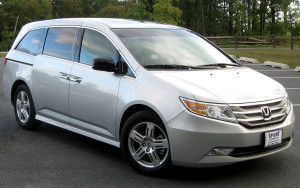 5.87 – 2014-2015 Honda Odyssey.
5.87 – 2014-2015 Honda Odyssey.
5.15 – 2011-2013 Honda Odyssey.
The current generation Odyssey is not only the safest minivan you can buy today for surviving side impacts, it’s also the safest minivan on the road to be in if you’ve got to be in a rollover. It features ESC, rollover-sensing side airbags, and a roof capable of supporting nearly 6x its weight before life-threatening levels of caving in. This is as good as it gets right now. It’s not surprising that the initial version of this generation, the ’11-’13 Odyssey, was only the second minivan ever estimated by the IIHS to have had a zero driver death rate (the first was the ’08 Sienna).
It’s worth comparing the latest Odyssey to previous ones to see how far it has come. The ’11-’13 Odyssey had a 5.15 SWR, which was a huge step forward from the ’05-’10 generation, which Honda estimated was 2.2x weaker, suggesting an SWR of 2.34, even though it was never officially measured by the IIHS or released by Honda. The ’11-’13 Odyssey, however, with its 5.15 SWR, ESC, and roll-sensitive airbags, is the next best option on this list after the ’14-’15 Odyssey.
Returning to the ’05’-10 Odyssey, it’s worth noting that a 2.34 SWR, while “poor” on the IIHS’ scale (the marginal/poor threshold is 2.5, while the acceptable/marginal threshold is 3.25), was still significantly higher than the NHTSA’s archaic 1.5 requirement. The ’05-’10 Odyssey had a driver death rate of 17, with rollovers comprising 3 of the 5 projected single vehicle collisions. This generation of the Odyssey came with roll-sensitive airbags and ESC, as has every generation since.
My full 3 across car seat guide to the various generations of the Odyssey is here.
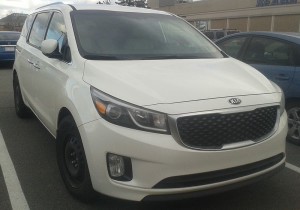 4.82 – 2015 Kia Sedona.
4.82 – 2015 Kia Sedona.
The current generation Sedona includes ESC and roll-sensitive airbags, but it trails every Odyssey between ’11 and ’15 due to a 4.82 SWR. However, it still can be expected to show an impressive level of performance in rollover avoidance and survival.
The previous generation Sedona (’06-’14) was a much poorer vehicle in comparison on paper, but still a safe vehicle in practice. While it did have ESC, it did not have roll-sensing side airbags, but regular side airbags, and it also had a 2.31 SWR on the roof, which was about identical to that of the ’05-’10 Odyssey.
However, despite the fact that it didn’t feature roll-sensing airbags, its overall ’08-’11 driver death rate was almost identical to that of its equivalent-generation Odyssey at 16, while its rollover death rate from the 0 estimated single vehicle fatalities was zero (unlike 3 in the ’05-’10 Odyssey). This serves as a potent reminder of the complexities of crash survival, and of how no single metric can provide the answers to every safety-related question.
My full 3 across car seat guide to the various generations of the Sedona is here.
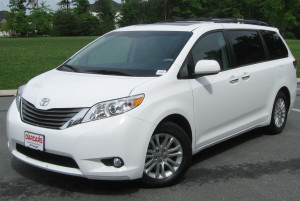 4.12 – 2015 Toyota Sienna.
4.12 – 2015 Toyota Sienna.
The ’15 model year of the current generation Sienna includes ESC and roll-sensitive airbags, but it trails not only every Odyssey since ’11, it also trails the ’15 Sedona. That said, it’s still a very solid choice for rollover risk mitigation with its 4.12 SWR.
The biggest issue with the Sienna comes with its ancestor. The ’11-’14 model years share the 4.12 SWR and ESC, but, much like the ’06-’14 Sedona, lack roll-sensitive side airbags. As a result, I’d place the ’11-’14 Sienna behind the ’05-’10 Odyssey, which, despite its lower SWR, did feature roll-sensitive airbags.
The ’11 Sienna also featured a surprisingly high DDR of 27, in which an alarming 15 of the 16 single vehicle deaths were attributable to rollovers. Given the strong roof and presence of ESC, I have to wonder whether the near-complete alignment between rollovers and single vehicle fatalities in that model year were related to the lack of roll-sensitive airbags.
Whatever the reason, I’d also rank the ’11 Sienna behind the ’06-’14 Sedona, which had a DDR of 16 with 0 single vehicle rollover deaths, and behind the ’08 Sienna, which included ESC and side airbags but no roll-sensitive function and no public roof score, yet still achieved a DDR of zero.
My full 3 across car seat guide to the various generations of the Sienna is here.
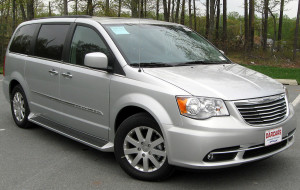 2012-2015 Chrysler Town & Country (not recommended) / Dodge Grand Caravan (not recommended).
2012-2015 Chrysler Town & Country (not recommended) / Dodge Grand Caravan (not recommended).
I unfortunately can’t recommend either the Town & Country or its Dodge twin, the Grand Caravan, due to the fact that neither vehicle includes roll-sensing airbags as standard features. They aren’t even available as options. Given the fact that ESC and roll-sensing airbags have been standard features with Honda since ’05 and Kia and Toyota since ’15, I can’t recommend minivans that haven’t joined the party. Hopefully Fiat Chrysler Automobiles will make these changes soon; they have roll-sensing airbags on a number of their SUVs already, including the Dodge Durango, Jeep Grand Cherokee, Jeep Cherokee, and Dodge Journey, so they’re well aware of the technology. They simply need to make it standard and available for the safety of the families who trust them with their lives.
For what it’s worth, I do like that the T&C / Grand Caravan have 4.51 SWRs, and have had them since ’12.
My full 3 across car seat guide to the various generations of the Town & Country is here, while the equivalent guide to the Grand Caravan is here.
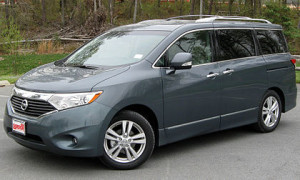 2011-2015 Nissan Quest (not recommended).
2011-2015 Nissan Quest (not recommended).
Unfortunately, I can’t recommend the Quest for the same reason I couldn’t recommend either the Town & Country or the Grand Caravan: it lacks roll-sensing side airbags. Even worse than the aforementioned SUVs, it’s the only ’15 model year minivan that doesn’t feature a good roof score; it falls on the low end of the “acceptable” range with an SWR of 3.36. While this is better than the ’05-’10 Odyssey’s SWR, as well as that of the ’06-’14 Sedona and almost certainly the ’08-’11 Sienna’s, it’s 2015, and every new vehicle on the road should be starting with a 4.0 SWR, not aiming to achieve it. Nissan can and needs to do better.
What do I do if my minivan scored poorly or wasn’t here at all?
The safest minivans for both avoiding and surviving rollovers are, and have been for a while, made by Honda, Kia, and Toyota. However, many readers may not have one of the minivans I described positively above. What do you do?
Personally, I’d do whatever possible to buy a recommended minivan if at all possible if this is a priority. At the very least, a minivan with ESC is well worth the money. If possible, buy one with both ESC and side airbags. Better still is one with ESC and roll-sensing airbags. And best of all is one with ESC, roll-sensing airbags, and an SWR of 4 or more. Vehicles that rank well in these areas tend to rank well in other areas (e.g., side impact protection, frontal crash protection), making them much safer vehicles overall.
We can’t control everything. The safest option is still not driving at all, followed by driving as little as possible. But if you’ve got to drive, drive safely, and do your best to choose a safe vehicle. If you’re going to use it with children, definitely check out the plethora of best practice articles I’ve written here on choosing safe car seats, installation tips, seat reviews, and more information to help you make informed decisions.
I loved writing this article, and I hope you enjoyed reading it. I look forward to writing more articles examining various factors in car safety design and how they relate to keeping you and your loved ones safer while on the road. Stay tuned, remember to avoid common mistakes parents make with car seats, and check out some 3 across car seat guides while you’re here.
If you find the information on car safety, recommended car seats, and car seat reviews on this car seat blog helpful, you can shop through this Amazon link for any purchases, car seat-related or not. Canadians can shop through this link for Canadian purchases.

